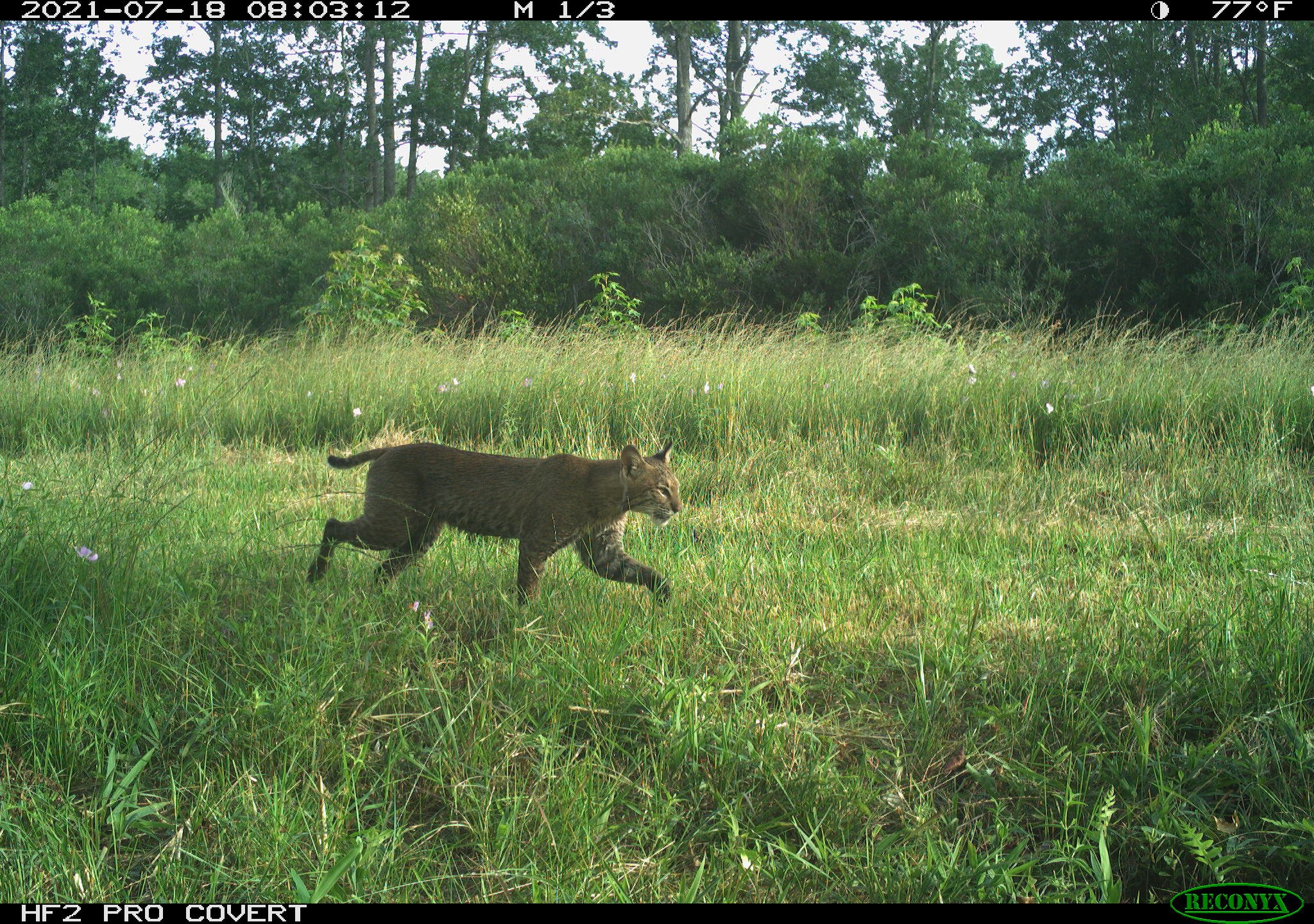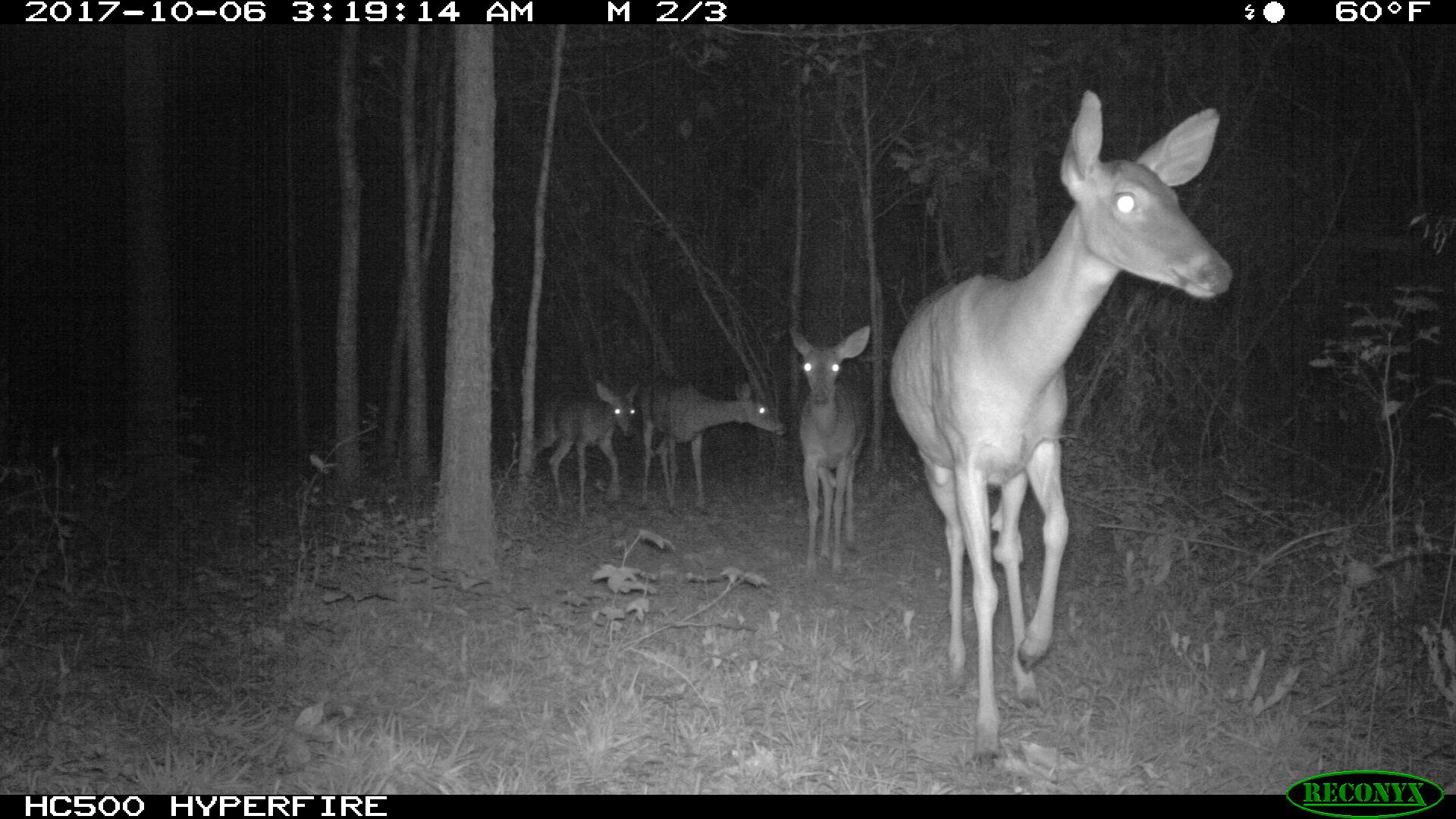Part Two: Results in the Red Wolf Ecosystem
Seven years after we put up our first cameras, we were ready to analyze the results. Fortunately, given the hundreds of thousands of images that had built up by then from years of camera trapping, we were able to partner with Dr. Roland Kays at the North Carolina Museum of Natural Sciences in Raleigh to get the photos entered into an online database.
We started with eMammal, and then, in recent years, moved on to Wildlife Insights, a platform that brings an AI-assisted approach to generating provisional identifications of the animals in each photo. In the summer of 2022, we worked with Roland and a North Carolina State University master’s student, Alexa Murray, to analyze the accumulated data.
By that point, it had become painfully clear that the red wolf population had withered under the onslaught of illegal killings. Only 15-20 red wolves were left by late 2020, with only eight confirmed animals still wearing functional radio collars, putting the red wolf back on the knife-edge of re-extinction in the wild.
So, the research approach we took was to examine the trends in detection rates for a range of other wildlife species in the context of a rapidly declining red wolf population. The red wolves held on at Alligator River NWR (better protected) much longer than they did off-refuge. I think they only collapsed at the refuge when the breeding male of the Milltail pack died of old age, and suddenly, there weren’t enough wolves elsewhere to replace him.
What did we find when Alexa ran the numbers? As the red wolves declined over the years, we saw increases in the detection rates for many other species. Bears, raccoons, and bobcats doubled in their detection rates from 2018-2021. Black bears were already far more numerous at the national wildlife refuges than the wolves.
In fact, bears were the number one most detected wildlife species in our study, with 20,554 detection events, beating out the number two species, white-tailed deer with 12,373 detection events, by a wide margin.
It is possible that the decline in wolves made more room for bear populations since wolves and bears have some overlap in their diet. Equally possible is the idea that the bears were still recovering their population anyway, reaching densities that have rarely been seen elsewhere in the eastern U.S.
Bobcats were much more likely a close competitor for the wolves, as both species enjoy hunting rodents and rabbits, and the red wolves likely harass the bobcats to a certain extent when they encounter each other in the fields. Raccoons, on the other hand, are a known primary prey item for the red wolf, and I think that what we were seeing was a classic “mesopredator release” phenomenon where the increasing absence of the red wolf led to sharp growth in the raccoon population.
What about the deer? Well, as I mentioned above, deer were the second-most frequently detected wildlife species during our study, and they showed up at all of our camera sites. The deer detection rates increased somewhat during the period of red wolf decline but then experienced a difficult-to-explain sudden drop in 2020 (when wolf populations were at their lowest), perhaps due to some combination of disease or weather.
What we did not see, however, was any evidence that the wolves had been causing a collapse in deer populations, even at the start of our study when there were still plenty of wolves around (see the three-year video linked here for visual proof).
It wasn’t just the red wolves that were eating the deer at these refuges, by the way. Black bears are talented at finding and eating fawns, as are bobcats and coyotes. And the national wildlife refuges, while closed to bear hunting, are open to human hunters pursuing deer, generally with large packs of dogs.
So even with all of these potential predators running around, and even in low-nutrient “Pocosin” wetlands not known for their deer productivity, white-tailed deer remained common and widespread during the length of our study. This fact completely discredits the “wildlife disaster” claims made by the wolf opponents.
Now the challenge is to find ways to communicate our findings with the people who live in the current red wolf recovery area and who hold the future of the species in their hands.
If you’re interested in wolf ecology, I certainly hope you’ll take the time to read the full study, which was just published (open access) in the journal Animal Conservation. This investigation is by no means the end-all of research that could be completed trying to understand the role of red wolves in regulating ecosystems. It’s rather the opposite – I see it as a promising beginning.
For example, we have already started a project to see if there is any chance that the presence of the red wolves at Alligator River NWR is a driver of the fact that the fields at the refuge host really dense populations of bobwhite quail. Bobwhites are an important ground-nesting gamebird species that have been declining across the southeast for decades, and one possible reason for that decline is the overabundance of nest-raiding mesopredators like raccoons.
We collected two field seasons of data on quail calling rates at sites across the red wolf recovery area in 2020 and 2021. We will be comparing that data to the camera detection rates for wolves and mesopredators, to see if sites with more wolves have less mesopredators and more quail.
Ultimately our camera work is correlational in nature so far – we’ve observed what has happened over time while the wolves declined. Now that the U.S. Fish and Wildlife Service has recommitted themselves to their red wolf program and the wolves are on the uptick again, we would like to see what happens to the same wildlife species as the red wolves recover – that data would provide key insights into what trends are actually being driven by the wolves themselves.
However, in late 2022, the few remaining staff at Alligator River NWR informed us that they were being forced (due to lack of staff capacity) to cancel our research permits at the refuge. Turns out that staffing numbers across America’s national wildlife refuge system are down 25% from 2011 levels according to the National Wildlife Refuge Association, due to years of budgetary neglect.
I don’t think many nature-loving people are aware of how much our cherished national wildlife refuges are being neglected, but we will certainly be doing what we can to fix the crisis. Red wolves and so many other species depend on making sure these core protected areas stay intact, well-managed, and open to scientific research.
I finally had the chance to drive through Yellowstone’s iconic Lamar Valley this August with my family, and the views and the wildlife were certainly incredible. Given a choice, though, as a fan of all of the reptiles and amphibians (and even the diversity of biting insects) that you can find at Alligator River and Pocosin Lakes NWR’s, I’d rather spend my time with the elusive red wolves, trying to figure out more about how Canis rufus fits into the ecological story of the Southeast.
My kids have grown up visiting the coastal North Carolina refuges to check cameras and scout for red wolves and rattlesnakes. I plan to keep taking trips down there in the years ahead, in the hopes that someday my grandchildren’s generation will get a chance to have their spines tingle to the music of wild red wolves howling under the southern stars.
Read part one of this series to understand the history of red wolves here.





